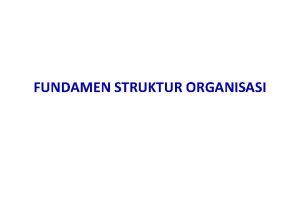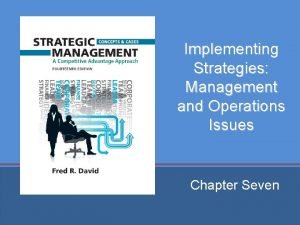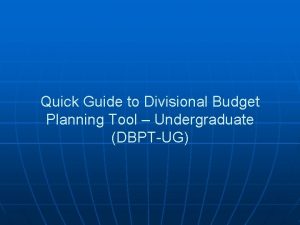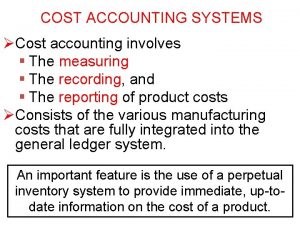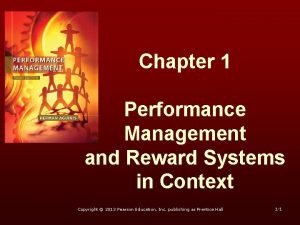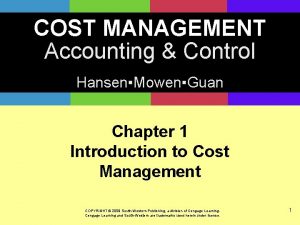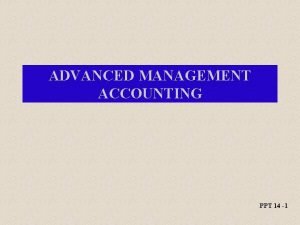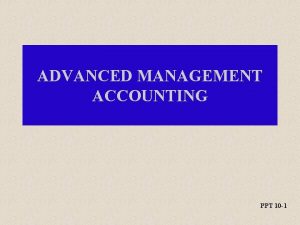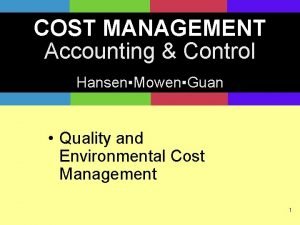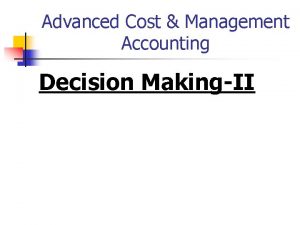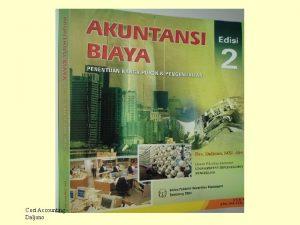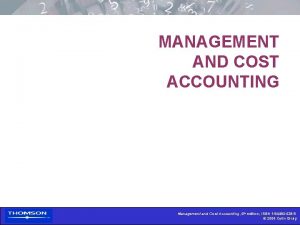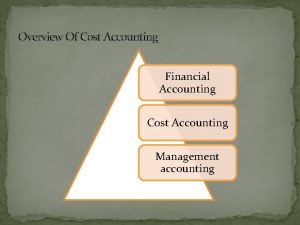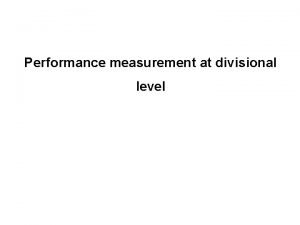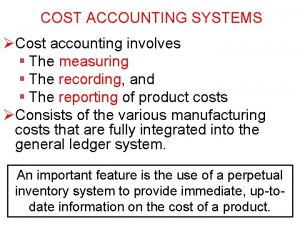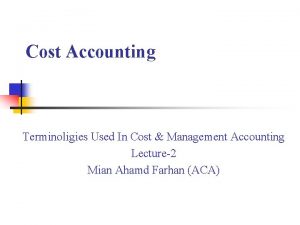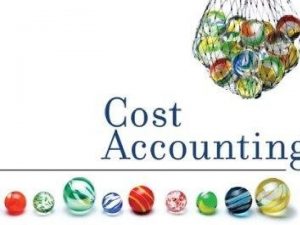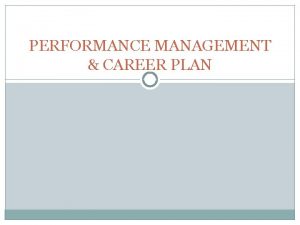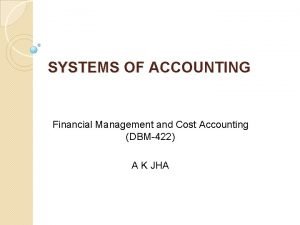Divisional Performance Evaluation Management Accounting Systems Cost Accounting



















- Slides: 19

Divisional Performance Evaluation

Management Accounting Systems Cost Accounting Systems Budgeting Systems Variance Analysis Transfer Pricing Performance Measurement Systems

Agenda • Describe the mechanics of computing accounting-based measures of financial performance – ROI (Return on Investment) – RI (Residual Income) – EVA (Economic Value Added) • Discuss the strengths and shortcomings of these accounting-based performance measures • Example: Ross Parts • Takeaway

Motivating Accounting Performance Measures • The most common accounting measure of performance is income • Since external investors are interested in income, it is an obvious choice for evaluating units of the organization • It also provides a common metric with which to compare different units in the organization

ROI • Return on investment (ROI) or return on assets (ROA) is an accounting measure of income divided by an accounting measure of investment ROI = Income ÷ Investment

ROI Strengths • ROI is easy to compute • ROI is a ratio – Can be compared across divisions

ROI Weakness: Dilution of ROI • A problem with ROI is that it is a ratio rather than a sum • The company’s cost of capital is 15 % – Your division’s ROI is currently 25 % • You see an opportunity that yields 20 % – What does headquarters (if it knew about this opportunity) think about taking on this opportunity? [Yes --- 20% pulls its 15% up] – What do you as a divisional manager compensated on ROI think about taking on this opportunity? [No --- 20% pulls your 25% down] • This organizational inefficiency is called: ROI Dilution Problem

Residual Income (RI) • RI = Income – (Cost of Capital x Investment) • RI is a dollar figure • RI is positive if a project generates income greater than the project’s cost of capital. • Colloquial Interpretation – Suppose cost of capital is 15%. You pay the lender his interest of 15%, and “keep” the rest of the income for yourself.

Strengths of Residual Income Measure • No ROI dilution problem – Suppose the corporate target cost of capital is 15% – The divisional manager compensated on RI will take on any opportunity that generates more than 15% • Taking on such an opportunity can only increase the divisional manager’s RI dollars. – Colloquially speaking, the manager gets to “keep” any income over and above the “interest charge” of 15%.

Different Treatment of Input Resources Division A hires a scientist (input resource) to improve its operations. That scientist costs $100, 000. Division B gets a machine (input resource) instead that also costs $100, 000 and has the same economic impact on efficiency. • RI = Income – (Cost of Capital x Investment) – Because wages are expensed, the entire $100, 000 paid to the scientist hits Division A’s income immediately. – Because machine purchases are capitalized, only the first year depreciation hits Division B’s income immediately.

Economic Value-Added (EVA) • EVA reduces reporting distortions in residual income – Adjust reporting of several income items EVA = Adjusted Income – [cost-of-capital x (Total assets – current liabilities)] NOTE: There are many variations to EVA applied in practice

Agenda • Describe the mechanics of computing accounting-based measures of financial performance – ROI (Return on Investment) – RI (Residual Income) – EVA (Economic Value Added) • Discuss the strengths and shortcomings of these accounting-based performance measures • Example: Ross Parts • Takeaway

Example: Ross Parts North Division Profit South Division $200 $390 $2, 000 $3, 000 Current liabilities $200 Cost of capital 15% R&D expenditure* $500 $0 Investment (Assets) * (Assumed to benefit this period and the following three periods equally – a total benefit period of four years. )

Example: Ross Parts North Division ROI Residual Income South Division ($200 ÷ $2, 000) ($390 ÷ $3, 000) = 10% = 13% $200 – (15% x $2, 000) = – $100 $390 – (15% x $3, 000) = – $60 Note: Residual Income for North Division is negative in part because all the R&D has been expensed, resulting in a low income figure.

R&D Amortization For North Division Amortization Schedule of $500 R&D expenditures over four periods This period +1 This period +2 This period +3 Traditional R&D Expense 500 0 Amortized R&D Expense 125 125 Remaining Capitalized R&D Adjustment to Income Adjustment to Assets 375 +375 250 -125 +375 125 -125 +250 0 -125 +0

Ross Parts Current Period EVA North Division “Adjusted” profit: $200 + $375 = $575 “Adjusted” assets: $2, 000 – $200# + $375 = $2, 175 $575 – (15% x $2, 175) = $248. 75 > 0 EVA: South Division “Adjusted” profit: $390 = $390 “Adjusted” assets: $3, 000 – $200# = $2, 800 $390 – (15% x $2, 800) = – $30 EVA: # $200 is current liabilities that we subtract in our definition of EVA assets

Another EVA Example: Lincoln, Inc 1997 1998 1999 Revenue 50 100 80 R&D Expense (60) Assets (Beginning of year) 100 100 Income (10) 100 80 Residual Income (10) – 15% 100 = ($5) 100 – 15% 100 = $85 80 – 15% 100 = $65

Another EVA Example: Lincoln, Inc Amortization Schedule of $60 R&D expenditures over three periods 1997 1998 1999 Revenue 50 100 80 R&D Expense (20) “Left over” R&D Assets 40 20 0 Assets (Beginning of year) 100 100 Adjusted Assets 100 140 120 Adjusted Income 30 80 60 Residual Income 30 – 15% 100 = $15 80 – 15% 140 = $59 60 – 15% 120 = $42

Takeaway • Some commonly used financial performance measures are – Income – Return on Investment (ROI) – Residual Income – EVA • Organizational Issues: – Each measure has strengths and weaknesses – Effective use requires • Management Judgment and Leadership
 Job order costing
Job order costing Basis of strategy
Basis of strategy Structure of samsung
Structure of samsung Bloqueio divisional postero inferior
Bloqueio divisional postero inferior Divisional org structure
Divisional org structure Worldwide product divisional structure
Worldwide product divisional structure Multi-focused grouping
Multi-focused grouping Sbu organizational structure
Sbu organizational structure Divisional budget
Divisional budget Bentuk bagan organisasi
Bentuk bagan organisasi The two basic types of cost accounting systems are
The two basic types of cost accounting systems are Performance management vs performance appraisal
Performance management vs performance appraisal Behaviorally anchored rating scales
Behaviorally anchored rating scales Performance management and reward system
Performance management and reward system Cost management accounting and control
Cost management accounting and control Activity based costing ppt
Activity based costing ppt Advanced cost and management accounting ppt
Advanced cost and management accounting ppt Cost management accounting and control
Cost management accounting and control Responsibility centers in management accounting
Responsibility centers in management accounting Relevant cost in management accounting
Relevant cost in management accounting






